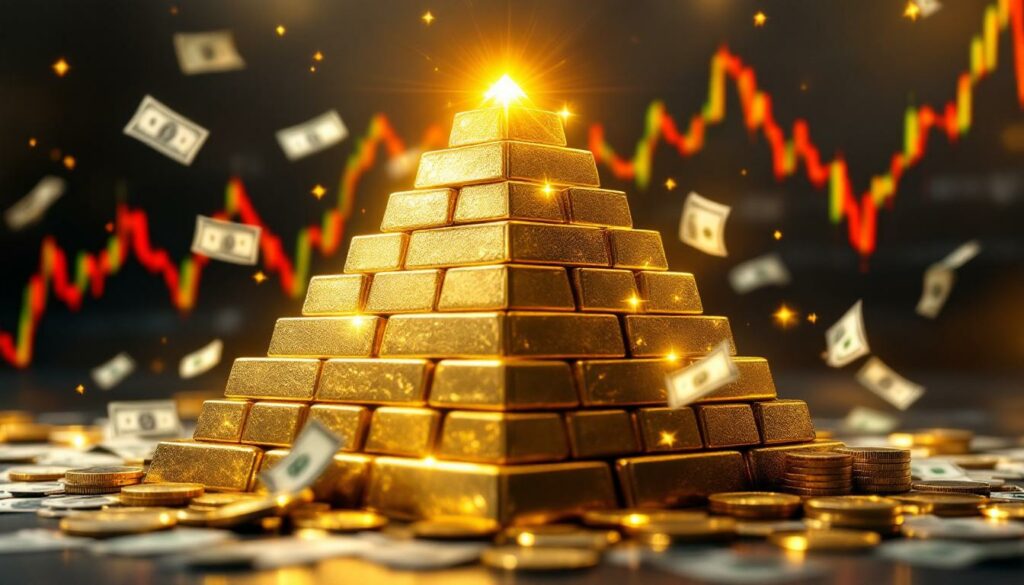What's Driving Gold and Silver Prices to New Heights?
The precious metals market has witnessed remarkable momentum in recent months, with gold achieving new all-time highs and silver surging to 13-year highs approaching the $40 mark. This dramatic price action reflects growing investor concern about global economic stability and the search for reliable stores of value.
Recent Price Movements in Precious Metals
Gold's steady climb to record territory has been accompanied by silver's even more dramatic percentage gains, creating what industry experts describe as a powerful bull market across the precious metals complex. These metals have demonstrated strong technical breakouts from long-term consolidation patterns, suggesting the potential for sustained upward momentum.
Mike Melissinos, founder of Melissinos Trading, emphasizes the strength of the current trend: "The only logical play is to be long [on gold/silver]. We are entering the escape velocity part of our society here."
This "escape velocity" metaphor aptly describes how precious metals tend to accelerate their gains once certain economic thresholds are crossed, particularly when currency stability comes into question. Recent gold all‐time highs analysis indicates that these movements could be the beginning of a sustained bull run.
Economic Factors Behind the Precious Metals Rally
The unprecedented levels of government debt across major economies have created mounting pressure on global currencies, particularly the US dollar. Interest payments on US debt have reached concerning levels that threaten long-term fiscal sustainability. When governments begin borrowing simply to pay interest on existing debt, history shows precious metals typically thrive.
"Interest payments are becoming mathematically impossible to sustain without currency devaluation. This isn't a political problem anymore—it's a math problem." — Mike Melissinos
This debt spiral creates several conditions favorable to precious metals:
- Loss of faith in fiat currency as debt-to-GDP ratios expand beyond historical norms
- Negative real interest rates (nominal rates minus inflation) make non-yielding assets more attractive
- Monetary expansion as central banks attempt to manage debt through currency creation
- Institutional reallocation toward hard assets as portfolio hedges
The ongoing US debt and inflation trends continue to support higher gold and silver prices as investors seek protection from currency devaluation.
Changing Market Dynamics vs. Traditional Assets
Perhaps most telling is how precious metals are performing relative to traditional financial assets like stocks and bonds. Gold and silver price charts show a clear upward trajectory when compared to major indices like the S&P 500, indicating a potential rotation from equities to precious metals.
This relative strength often signals broader economic concerns among institutional investors seeking to protect capital during periods of financial uncertainty. The metals' outperformance suggests a fundamental reassessment of risk across asset classes.
Key indicators of this shift include:
- Rising gold/S&P 500 ratio
- Increasing institutional fund flows into precious metals ETFs
- Growing premiums for physical metals over spot prices
- Expanding open interest in futures contracts
As traditional safe havens like government bonds lose appeal due to sovereign debt concerns, precious metals are reclaiming their historical role as wealth preservation assets during periods of monetary stress. You can track these movements through live gold and silver price charts for the most current market data.
How Are Government Policies Affecting Precious Metals Prices?
Government fiscal and monetary policies have emerged as primary drivers of precious metals performance, creating structural support for higher prices regardless of short-term market fluctuations.
Impact of Fiscal Spending on Metal Valuations
Recent government spending initiatives continue to expand rather than contract, despite periodic discussions about fiscal responsibility. What some analysts refer to as the "big beautiful bill" represents the persistent pattern of government expenditure growth exceeding economic growth or tax revenue.
This fiscal expansion has significant implications for precious metals:
- Expanding government debt must eventually be serviced through higher taxes, economic growth, or currency devaluation
- Entitlement spending rigidity makes meaningful budget cuts politically difficult
- Military and infrastructure commitments further constrain fiscal flexibility
- Interest payment growth creates a compounding problem as rates rise
The political reality is that meaningful spending reduction faces enormous obstacles. As Melissinos notes: "Congress doesn't want to cut military spending… They're not playing games." Similar resistance applies to entitlement reform, with politicians reluctant to propose changes that might alienate voters.
Monetary Policy Considerations
While central bank interest rate decisions remain important for short-term price movements, precious metals markets increasingly look beyond these tactical adjustments to focus on structural monetary issues. The Federal Reserve's dual mandate of price stability and maximum employment often conflicts with the fiscal reality of servicing government debt.
This creates several scenarios favorable to precious metals:
- High rates threaten government solvency through increased interest payments
- Low rates risk currency devaluation and inflation
- Quantitative tightening becomes difficult to sustain when government financing needs increase
- Yield curve control may eventually become necessary, supporting non-yielding assets like gold
The monetary policy dilemma means precious metals can potentially perform well regardless of whether central banks raise or lower rates, as neither path resolves the underlying fiscal imbalances.
Global Currency Implications
The US dollar's multi-year strength may be reaching its limits as fiscal and monetary contradictions become more apparent. Precious metals often serve as early indicators of potential currency regime changes, with their rising prices signaling decreasing confidence in fiat alternatives.
After years of dollar strength and commodity weakness, market participants are reassessing currency valuations in light of unsustainable debt levels across major economies. This reconsideration extends beyond the US dollar to other reserve currencies facing similar fiscal challenges.
"Markets are looking beyond short-term policies… they see the bill, which is big because this is what they all do." — Mike Melissinos
Gold's traditional role as an international reserve asset outside the banking system makes it particularly attractive during periods of currency uncertainty, while silver benefits from both monetary demand and industrial applications. Tracking the gold‐silver ratio insights can provide important clues about potential future price movements.
What Makes This Precious Metals Bull Market Different?
Today's precious metals market differs significantly from previous cycles in ways that could amplify price movements beyond historical precedents.
Modern Market Structure and Accessibility
Unlike previous bull markets where physical ownership dominated, today's market offers unprecedented accessibility through financial products like ETFs, mutual funds, and digital platforms. This democratized access allows more participants to enter the market quickly with minimal friction.
The implications of this structural change include:
- Faster capital deployment when sentiment shifts positive
- Greater price volatility as retail traders move in and out
- Reduced physical premiums due to financial alternatives
- Expanded potential investor base beyond traditional precious metals buyers
As Melissinos observes: "This isn't your grandfather's market… You have so much access to money and a speculative culture." This combination can create self-reinforcing price movements when momentum attracts additional participants.
Speculative Elements and Market Psychology
The current market environment features a speculative culture with unprecedented access to capital. Social media, commission-free trading, and widespread financial content have created conditions where retail investors can quickly coordinate around emerging trends.
This speculative component can produce:
- Faster price appreciation during bull phases
- Sharper corrections when sentiment shifts
- Higher ultimate price targets than fundamental models suggest
- Greater public participation at later stages of the bull market
Recent experiences in markets like cryptocurrencies, meme stocks, and technology shares demonstrate how modern market psychology can drive prices far beyond traditional valuations when speculative fervor takes hold. The silver squeeze dynamics observed in recent years exemplify this new market reality.
Breaking Historical Price Barriers
Previous all-time highs, such as silver's 1980 peak near $50, should not be viewed as permanent ceilings in the current monetary environment. The fundamental difference is the vastly expanded monetary base compared to previous cycles.
"There's trillions and trillions more in the system now… don't think what's happened in the past is the high for the remainder of time." — Mike Melissinos
This expanded monetary base creates potential for prices that would have seemed impossible in earlier cycles. When adjusted for money supply growth since previous peaks, gold and silver's inflation-adjusted highs would be significantly higher than their nominal records.
Key factors supporting higher potential price ceilings include:
- Expanded global money supply providing more capital for commodity investments
- Reduced mining productivity as high-grade deposits become scarcer
- Growing industrial demand for silver in green technology applications
- Increased institutional allocation to inflation-hedging assets
These structural changes suggest that comparing current prices to historical highs without monetary context may underestimate the potential range for this bull market cycle.
How Do Gold and Silver Compare as Investment Options?
While gold and silver share many characteristics as precious metals, they offer different risk-reward profiles and respond differently to various economic conditions.
Performance Comparison: Gold vs. Silver
Gold has historically provided more stable returns with lower volatility, serving primarily as a monetary metal and inflation hedge. Silver, with its dual nature as both monetary and industrial metal, typically exhibits greater price volatility and often outperforms gold during strong bull markets.
The key performance differences include:
- Volatility ratio: Silver typically experiences 1.5-2x the price volatility of gold
- Bull market gains: Silver has historically delivered larger percentage gains during precious metals bull markets
- Drawdown risk: Silver generally suffers deeper corrections during consolidation phases
- Economic sensitivity: Silver shows greater correlation to industrial production than gold
These characteristics make silver potentially more rewarding but also riskier than gold, particularly for investors with shorter time horizons or lower risk tolerance. Understanding gold technical performance can help investors make more informed decisions.
Industrial Demand Factors for Silver
Unlike gold, which has minimal industrial consumption relative to its above-ground supply, silver faces significant industrial demand from sectors including:
- Electronics and electrical contacts
- Photovoltaic (solar) panels
- Medical applications and antimicrobial uses
- Photography (declining but still relevant)
- Automotive (especially in electric vehicles)
This industrial component creates a demand floor that can support prices during economic expansion but may also pressure prices during severe economic contractions when industrial consumption declines.
The green energy transition represents a particularly important demand driver for silver, with each solar panel requiring approximately 20 grams of silver. As renewable energy deployment accelerates globally, this demand segment could significantly impact the silver supply-demand balance.
Portfolio Allocation Considerations
Investors must consider their risk tolerance, investment timeline, and overall portfolio strategy when allocating between gold and silver. A balanced approach might include positions in both metals to capture different aspects of the precious metals market.
Allocation strategies to consider:
- Conservative approach: Higher gold allocation (70-80%) with smaller silver position (20-30%)
- Balanced approach: Equal allocation between gold and silver
- Aggressive approach: Higher silver allocation (60-70%) with smaller gold position (30-40%)
- Tactical approach: Adjusting allocations based on the gold/silver ratio
For investors seeking exposure to the sector without holding physical metals, additional options include mining stocks, royalty companies, and ETFs. Each offers different advantages in terms of leverage to metal prices, operational risk, and liquidity.
What Technical Indicators Are Signaling for Precious Metals?
Technical analysis provides valuable insights into potential price movements for gold and silver, with current indicators suggesting continued strength in the precious metals sector.
Chart Patterns and Breakout Levels
Gold's chart shows a clear breakout above previous resistance levels, confirming the strength of the current uptrend. After consolidating for years below its previous all-time high, gold's decisive move to new record territory represents a significant technical development.
Silver's technical picture reveals a powerful move above key moving averages with accelerating momentum. While still below its all-time high near $50, silver has broken through several important resistance levels, suggesting the potential for continued upward movement.
These breakout patterns typically indicate:
- Renewed investor interest after period of consolidation
- Diminishing overhead resistance as previous sellers are exhausted
- Potential for accelerated gains as momentum traders enter
- Technical target projections based on the height of previous consolidation patterns
While periodic consolidations should be expected given the magnitude of recent gains, the overall technical structure remains bullish for both metals. You can find detailed precious metals price charts to conduct your own technical analysis.
Volume Analysis and Market Participation
Trading volumes in both physical metals and related financial products have increased significantly, indicating broader market participation. This expanded interest typically supports sustained price movements rather than short-term spikes that quickly reverse.
Volume characteristics to monitor include:
- Increasing volume on up days versus down days
- Expanding open interest in futures contracts
- Growing assets under management in metals-focused ETFs
- Rising premiums for physical products over spot prices
These volume indicators suggest that the current price movement represents a fundamental shift in market sentiment rather than a temporary technical bounce.
Relative Strength Indicators
Precious metals are showing increasing relative strength compared to traditional asset classes like stocks and bonds. This outperformance often precedes larger moves as more investors recognize the trend and reallocate portions of their portfolios toward the stronger-performing sector.
Key relative strength measures include:
- Gold/S&P 500 ratio turning higher after multi-year decline
- Silver/Gold ratio potentially signaling increased risk appetite within the metals complex
- Metals/Bond ratio reflecting changing safe-haven preferences
- Mining stocks outperforming underlying metals prices (potential leading indicator)
These relative performance metrics help identify whether precious metals are gaining or losing momentum compared to alternative investments, providing context beyond absolute price movements.
How Might Precious Metals Perform in the Coming Years?
While specific price predictions involve significant uncertainty, structural factors supporting precious metals suggest potential for substantial appreciation over the medium to long term.
Long-Term Price Projections
Historical precedent suggests that precious metals bull markets typically unfold in stages, with the final phase often delivering the largest percentage gains. Current conditions indicate the potential for silver to eventually challenge or surpass its previous all-time high near $50, while gold could continue setting new records as monetary concerns persist.
Several factors support higher potential price targets:
- Expanded monetary base providing more liquidity for asset price inflation
- Growing sovereign debt creating currency debasement concerns
- Resource nationalism potentially restricting mining development
- Production challenges as easily accessible deposits become depleted
- Central bank diversification away from dollar reserves
When adjusted for money supply expansion since previous bull market peaks, inflation-adjusted targets for gold and silver would be substantially higher than their nominal historical highs.
Potential Market Scenarios
Several scenarios could unfold, ranging from steady appreciation to more dramatic price movements if currency confidence deteriorates rapidly:
Scenario 1: Orderly Revaluation
- Gradual price appreciation as institutional allocation increases
- Periodic healthy corrections of 10-20%
- Central banks maintain credibility while slowly diversifying reserves
- 3-5 year timeframe for significant new highs
Scenario 2: Crisis-Driven Spike
- Rapid price acceleration triggered by specific financial crisis
- Minimal correction opportunities for new investors
- Public participation driving final phase gains
- Potential for price overshoots beyond fundamental values
Scenario 3: Stagflationary Environment
- Persistent inflation combined with economic stagnation
- Gold outperforming most financial assets
- Silver benefiting from both monetary and industrial demand
- Extended bull market cycle with higher ultimate price targets
The velocity of money and public perception of inflation will likely play crucial roles in determining which scenario materializes, with more inflationary outcomes generally supporting higher ultimate price targets.
Warning Signs and Risk Factors
Despite the bullish outlook, investors should remain alert to potential warning signs that might indicate temporary market tops or changing fundamentals:
- Extreme bullish sentiment readings in market surveys
- Dramatic increase in mainstream financial media coverage
- Significant central bank intervention or policy shifts
- Rapid correction in related commodities or inflation expectations
- Substantial increase in mining company equity issuance
Precious metals markets can experience substantial volatility even within long-term uptrends, with historical corrections of 20-30% not uncommon even during secular bull markets. Risk management remains essential despite the positive long-term outlook.
"Markets don't move in straight lines. Expecting corrections along the way is prudent, but the structural drivers remain firmly in place." — Market wisdom
FAQ: Common Questions About Gold and Silver Investments
How do physical metals compare to ETFs and mining stocks?
Physical metals, ETFs, and mining stocks each offer different advantages and considerations:
Physical Metals:
- Direct ownership without counterparty risk
- Complete privacy and portability (for smaller amounts)
- No management fees, but storage/insurance costs
- Potential premium over spot price when purchasing
- May require assay when selling larger quantities
ETFs and Trust Products:
- High liquidity and ease of trading
- Minimal spread over spot prices
- Management fees (typically 0.25-0.75% annually)
- Potential tracking error versus spot prices
- Counterparty and custodian risk
Mining Stocks:
- Operational leverage to metal prices (potentially higher returns)
- Dividend income potential
Ready to Profit from the Next Major Mineral Discovery?
Get real-time alerts on significant ASX mineral discoveries with Discovery Alert's proprietary Discovery IQ model, turning complex mineral data into actionable insights for traders and investors. Begin your 30-day free trial today at Discovery Alert and position yourself ahead of the market.




